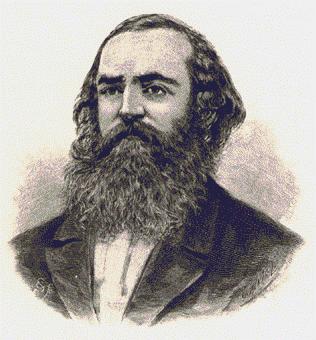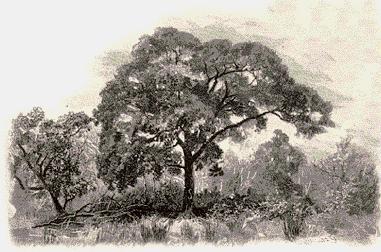|
JOHN M'DOUALL
STUART (1815-1866
Descended from a family steeped in military service, John was born in Dysart, Fife in Scotland on September 7th, 1815, in a sixteenth century home which now houses a museum in his honour. He was the son of William Stuart (an army captain) and his wife Mary McDouall. Orphaned in his early teens, he attended the Scottish Naval and Military, Edinburgh, and graduated as a civil engineer. At the age of 23 he embarked on the INDUS from Dundee, arriving in Adelaide on January 24th, 1839. He was listed on the manifest as: John McDouall STEWART single man. He entered the Government Survey Department and, despite primitive conditions in survey camps, found that normadic life in the bush appealed to him. His life, though, became a constant battle against ill health and poverty. He was appointed draughtsman for the 1844-46 expedition of Captain Charles Sturt into the interior, and gained valuable experience. John McDouall Stuart's services were frequently referred to in highly appreciative terms by his leader. On John's return to Adelaide in January 1846, he was incapacitated with scurvy for twelve months. He moved to Port Lincoln, where he surveyed pastoral leases, worked for fellow Scot and shipmate John Sinclair on his properties and tutored the Sinclair children.
The chief difficulty, however, had now been conquered. John McDouall Stuart's
report being so encouraging, the parliament voted a sum
of two thousand five hundred pounds, and with twelve men and forty-nine horses,
he left Chambers’ Creek station in the far north on New Year’s Day, 1861. This
time it was not the attacks of natives, but impenetrable scrub and the want of
water that drove him back after reaching to within four degrees of the northern
coast. Still trusted and still undismayed, he was again sent out within a month
of his arrival at Adelaide. The Victorian expedition under Burke and Wills had
already left Melbourne. It was a race between the colonies, and between Burke
and Stuart, which should first cross the continent. The latter was so confident
and undaunted that he promised the governor he would wash his feet in the Indian
Ocean before his return. The Victorian party had the start in point of time, and
the shortest distance to travel, its objective being the Gulf of Carpentaria;
but the story of its brilliant success and terrible disaster has already been
told. Stuart, taking advantage of his previously gained knowledge, and avoiding
the line of country he had found impracticable on former journeys, reached
without serious hindrance the fertile and well-watered regions within the
influence of tropic rains in 1862. He pronounced an immense extent of country he
traversed the finest he had ever seen. At length he heard the wash of the waves,
but kept the knowledge to himself till, penetrating through scrub matted with
vines, the party was startled by a shout of "the sea !" from F. W. Thring, the
third officer, who had ridden a little in advance.
Other explorers may have equalled him in personal qualities, but few have returned to the attack with more persistency, and the labours of none have been crowned with such signal success. By his means, territory was opened for pastoral occupation large enough to make half a dozen European kingdoms. The Imperial Government rewarded South Australian enterprise by annexing the Northern Territory to the colony, thus enlarging it by five hundred and twenty-three thousand six hundred and twenty square miles. In 1872 the Adelaide-to-Darwin Overland Telegraph was completed along Stuart's route, the stations on which have formed starting-points for further exploration. Central Mount Stuart, the Stuart Highway and the Stuart Range have been named in his honour. His statue stands in Victoria Square, Adelaide and the John McDoull Stuart Society was founded in 1964 by descendants of his companions to perpetuate his name and his achievements. |
Footnote: INSPECTOR TOLMER became inspired with John McDoull Stuart's success in explorating.
Mr Hodder drily put it "Mr Tolmer started to cross the continent, but soon returned.
The above was compiled by Diane Cummings from a number of sources, including:
South Australia's Greats (ISBN 0 9579430 0 9, published in 2001)
and The Picturesque Atlas 1886 - Historical Sketch of South Australia Part 3 - Inland Exploration
http://www.geocities.com/toby_meares/078.htm
Any and all copyrighted graphics are acknowledged as of their respective owners.

 Sturt's failure to reach the centre of the continent inspired Stuart's later achievements.
John McDouall Stuart was undeterred by the desolation witnessed while
on Sturt’s expedition, but profiting by its warnings, he made repeated
examinations of the country in the vicinity of Lake Torrens searching for
pastoral areas, in which he was highly successful. In 1854 John McDouall Stuart
was engaged to survey and prospect for minerals in the northern Flinders Ranges
by James and John Chambers and William Finke. During these journeys Stuart made the
important discovery that the vast shallow depression that had baffled Mr. Eyre
is not the continuous salt marsh it was by him supposed to be. Between May 1858
and January 1860 he led three expeditions int the Lake Eyre region, and found
a succession of artesian springs between the northern limit of Lake Torrens
and the southern extremity of Lake Eyre, the deposit from which formed mounds
rising considerably above the level of the surrounding country. These and other
permanent waters enabled him to fix a new base for northern exploration, and
suggest a more practicable route. Being suitably equipped by the public spirit
of his employers, he led a strong party in that direction. On April 14th, 1860,
he sighted what he called a most remarkable hill —like a locomotive with a
funnel. The latter proved to be a monolith of sandstone, quite perpendicular,
one hundred and fifty feet high from the base, twenty feet wide, and ten feet
deep. In honour of one of his patrons, he named it Chambers’ Pillar. Less than
three weeks afterwards, he found by his observations that he and two companions
and twelve horses, was camped in the centre of the continent. On April 22nd 1860,
he proudly unfurled the British flag on the highest point in the vicinity, which
he named Central Mount Stuart. From this point he pressed on northward, continuing
the plan of making short lateral trips east and west, so as to discover the most
practicable route, till by the hostility of savage blacks, scarcity of provisions,
and the weakness of his party, he was compelled to return.
Sturt's failure to reach the centre of the continent inspired Stuart's later achievements.
John McDouall Stuart was undeterred by the desolation witnessed while
on Sturt’s expedition, but profiting by its warnings, he made repeated
examinations of the country in the vicinity of Lake Torrens searching for
pastoral areas, in which he was highly successful. In 1854 John McDouall Stuart
was engaged to survey and prospect for minerals in the northern Flinders Ranges
by James and John Chambers and William Finke. During these journeys Stuart made the
important discovery that the vast shallow depression that had baffled Mr. Eyre
is not the continuous salt marsh it was by him supposed to be. Between May 1858
and January 1860 he led three expeditions int the Lake Eyre region, and found
a succession of artesian springs between the northern limit of Lake Torrens
and the southern extremity of Lake Eyre, the deposit from which formed mounds
rising considerably above the level of the surrounding country. These and other
permanent waters enabled him to fix a new base for northern exploration, and
suggest a more practicable route. Being suitably equipped by the public spirit
of his employers, he led a strong party in that direction. On April 14th, 1860,
he sighted what he called a most remarkable hill —like a locomotive with a
funnel. The latter proved to be a monolith of sandstone, quite perpendicular,
one hundred and fifty feet high from the base, twenty feet wide, and ten feet
deep. In honour of one of his patrons, he named it Chambers’ Pillar. Less than
three weeks afterwards, he found by his observations that he and two companions
and twelve horses, was camped in the centre of the continent. On April 22nd 1860,
he proudly unfurled the British flag on the highest point in the vicinity, which
he named Central Mount Stuart. From this point he pressed on northward, continuing
the plan of making short lateral trips east and west, so as to discover the most
practicable route, till by the hostility of savage blacks, scarcity of provisions,
and the weakness of his party, he was compelled to return. On July 25th 1862 he triumphantly raised the Union Jack on the northern coast at Chambers Bay. A record was cut deeply into a large tree, which still stands to bear its witness, and to another the Union Jack was securely nailed. after which the party returned along the same route. On November 26th, 1862 ten exhausted, gaunt and ragged men, on their limping, emanciated horses arrived at a remote stock run near Mount Margaret, in northern South Australia. With them, in a horse-drawn litter, was the skeletal figure of their leader, stretchered for 1,600 miles, nearly blind, with a crippled hand, and 'breath which reeked with the corruption of death'. They returned to Adelaide on January 21st 1863, greeted to a heroes' welcome.
On July 25th 1862 he triumphantly raised the Union Jack on the northern coast at Chambers Bay. A record was cut deeply into a large tree, which still stands to bear its witness, and to another the Union Jack was securely nailed. after which the party returned along the same route. On November 26th, 1862 ten exhausted, gaunt and ragged men, on their limping, emanciated horses arrived at a remote stock run near Mount Margaret, in northern South Australia. With them, in a horse-drawn litter, was the skeletal figure of their leader, stretchered for 1,600 miles, nearly blind, with a crippled hand, and 'breath which reeked with the corruption of death'. They returned to Adelaide on January 21st 1863, greeted to a heroes' welcome.